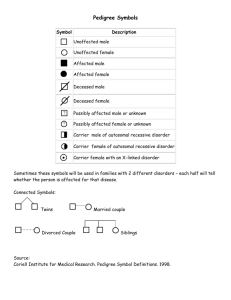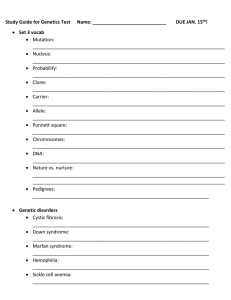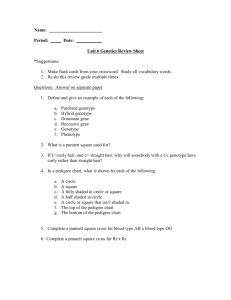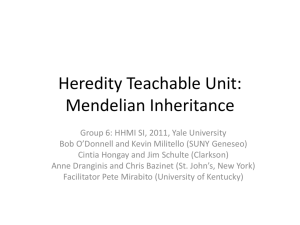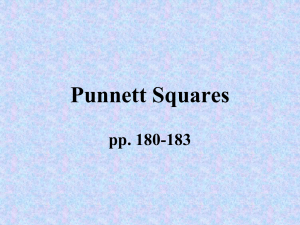MITOCW | MIT7_01SCF11_Un3Ses3_Rec_300k.mp4
advertisement
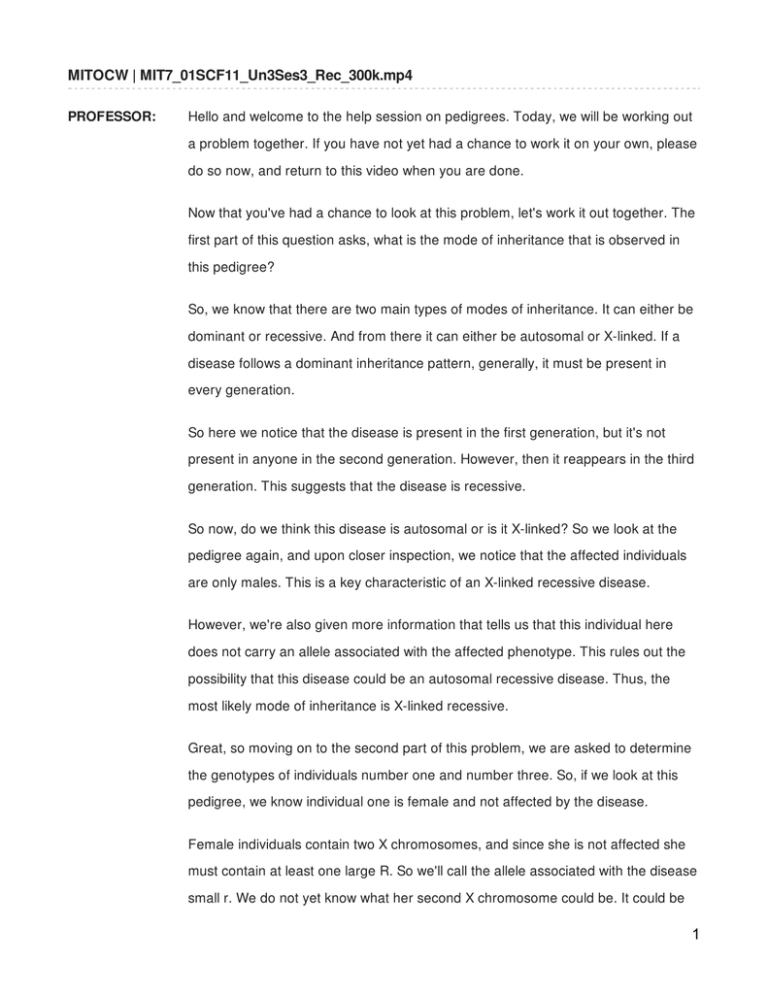
MITOCW | MIT7_01SCF11_Un3Ses3_Rec_300k.mp4 PROFESSOR: Hello and welcome to the help session on pedigrees. Today, we will be working out a problem together. If you have not yet had a chance to work it on your own, please do so now, and return to this video when you are done. Now that you've had a chance to look at this problem, let's work it out together. The first part of this question asks, what is the mode of inheritance that is observed in this pedigree? So, we know that there are two main types of modes of inheritance. It can either be dominant or recessive. And from there it can either be autosomal or X-linked. If a disease follows a dominant inheritance pattern, generally, it must be present in every generation. So here we notice that the disease is present in the first generation, but it's not present in anyone in the second generation. However, then it reappears in the third generation. This suggests that the disease is recessive. So now, do we think this disease is autosomal or is it X-linked? So we look at the pedigree again, and upon closer inspection, we notice that the affected individuals are only males. This is a key characteristic of an X-linked recessive disease. However, we're also given more information that tells us that this individual here does not carry an allele associated with the affected phenotype. This rules out the possibility that this disease could be an autosomal recessive disease. Thus, the most likely mode of inheritance is X-linked recessive. Great, so moving on to the second part of this problem, we are asked to determine the genotypes of individuals number one and number three. So, if we look at this pedigree, we know individual one is female and not affected by the disease. Female individuals contain two X chromosomes, and since she is not affected she must contain at least one large R. So we'll call the allele associated with the disease small r. We do not yet know what her second X chromosome could be. It could be 1 either another large R or it could be a small r. And she also would still not be affected by the disease. This male right here is affected by the disease. So he must have an X with a small r. Remember that males have one X chromosome and one Y chromosome. So now, making our way down to individual number three. Individual number three does not have the disease and is female, so again, must have two X chromosomes. One of the X chromosomes must come from her father and the other from her mother. The only X chromosome that her father can pass along to her is X small r. In order for her to not be affected with the disease, her other X chromosome must have a large R. She was able to get this genotype with her mother having either of these two genotypes. To make sure that both of these genotypes are possible for this mother, we need to examine her other children. Her son here is unaffected. So his genotype must have been X large R, Y. It's possible for him to get this genotype when the mother has either of these two genotypes. Similarly, this daughter could be unaffected just as this daughter was unaffected. So the mother can have either of these two genotypes. And we're unable to rule out one of them. So let me just write up the answer over here. All right, so far, so good. Next, we're asked to calculate the probability that individual A is affected. Individual A is over here at the bottom of the pedigree. In order for individual A to be affected, she must have the following genotype. The only way for her to get two little r's is for her to get one from her father and one from her mother. We know this is possible because her father is affected with the following genotype of Y, X small r. Her mother is not affected. So for her to get this small r, her mother must be a carrier for the disease, and have the genotype X large R, X small r. So in order to determine the probability that A is affected with both X small r's, we must also know the probability that her mother was a carrier for the disease. Let's 2 call her mother individual C. So, we know the genotypes of her parents. Her mother was a carrier. And her father did not have the disease, so his genotype was Y with X large R. So to calculate the probability that individual C is a carrier for the disease, let's go back over here and draw out a Punnett square. On one side, we're going to write the genotype of her father, which was Y because he's a male. And then, he was not affected by the disease, so it was X with a large R. Her mother was a carrier. So she had one copy that was X large R, and one copy that was x little r. So next, we want to know the probability that she was a carrier. The only ways you can get females is by looking at this top row here. So, for now, we're going to ignore the bottom row. Of the two possible ways to generate a female, only one of them is a carrier. So there's a 50% chance that a female will be a carrier. So this is a 50% chance that individual C is a carrier, which we will denote with this half filled in circle. All right, so now that we know the probability that C was a carrier, we need to know the probability that her progeny, A, was affected with the disease. Again, looking back over here, her progeny needs to inherit the X small r from the mother and the X small r from the father. So, once again, we can draw a Punnett square to better understand this. Individual A's father was indeed affected by the disease. So his genotype was X small r and Y. Her mother, we just calculated the probability of her being a carrier, so she is X large R, X small r. Now, we're looking at individual A, who is a female, so again, we can ignore the bottom row because this will be males. Here are the progeny which are female. Of the two possibilities, only the one on the right, X small r, X small r is affected by the disease. So there is a 50% chance that A will be affected by the disease given that her mother is a carrier of the disease. 3 Now to finish up this part of the problem, we need to multiply these two probabilities together because we're looking at the probability that C is a carrier, and the probability that A is affected with the disease. This gives us our answer of one fourth. All right, so, moving on to the last part of the problem. We need to calculate the probability that B is affected with the disease. So this isn't that hard now that we've drawn out all of these Punnett squares already. So, let's take a look back at our pedigree over here. If B is going to be affected with the disease, he must have the genotype Y, X with a small r. He gets the Y from his father and he must get this X with a small r from his mother. So again, we need the mother, C, to be a carrier. So let's go back to our Punnett squares over here. We know that there is a 50% chance that individual C is a carrier. Now we need to look at individual B being affected by the disease. So we can go ahead and fill in the bottom part of this Punnett square. So of these two males, that are possible, only one of them is affected with the disease. So again, there is a 50% probability that that child will be affected with the disease. Again, we are going to multiply these probabilities together. So the probability that the mother is a carrier, and that the son is affected with the disease, gives us one quarter. That concludes our problem on pedigrees. Thank you for joining us. 4
